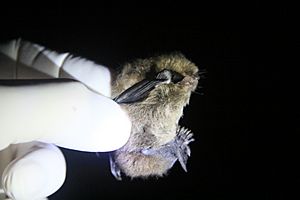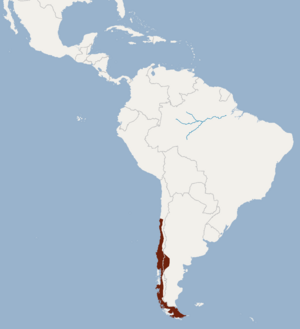Chilean myotis facts for kids
Quick facts for kids Chilean myotis |
|
|---|---|
 |
|
| Conservation status | |
| Scientific classification | |
 |
The Chilean myotis (Myotis chiloensis) is a type of vesper bat. It lives in the southern parts of South America. This small bat is special because it lives further south than almost any other bat in the world!
What Does It Look Like?
The Chilean myotis is a small bat. It measures about 7 to 9 centimeters (about 3 to 3.5 inches) long. This includes its tail. It weighs around 7 grams, which is about the same as a few paperclips!
Their fur color changes depending on where they live. Bats in the northern areas have pale, yellowish-brown fur. Those in the south have a darker, coffee-brown color.
These bats have wings that help them fly well. They are not super fast, but they are very good at turning and moving around in the air. Their tail is completely covered by a special skin flap called the uropatagium. This flap connects their legs and helps them fly.
Where Do They Live?
The Chilean myotis lives further south than most other bats. Only the southern big-eared brown bat lives in the same area.
This bat species mostly lives in Chile, south of about 30°S latitude. You can also find them in the western parts of Argentina. This includes the provinces of Neuquén, Río Negro, and Chubut.
At the very southern end of their range, they live across Tierra del Fuego. This is an island split between Chile and Argentina. They can live in many different places. These include dry, shrubby areas called Chilean Matorral in the north. They also live in cool, wet forests in the south.
Scientists do not currently recognize different types (subspecies) of the Chilean myotis.
How Do They Live?
Chilean myotises like to rest in safe, hidden spots. They roost in holes in trees, cracks in rocks, and caves. They also use human-made places like attics.
They come out at sunset to find food. They usually feed for about three hours. Then they go back to their roost. Unlike many other bats, they do not usually feed again later in the night.
Because they are small and have a low body temperature, these bats often enter a daily period of torpor. This is like a short, deep sleep. During torpor, their body temperature drops very low. It can be just half a degree Celsius above the air temperature. This helps them save energy.
They mostly eat flies that they catch while flying. They especially like crane flies. These bats use echolocation to find their food. This means they send out high-pitched sounds. Then they listen for the echoes to create a sound map of their surroundings. Their calls sweep down from 89 to 39 kHz. They send out these calls about every 95 milliseconds.
Female Chilean myotises usually give birth to one baby bat. This happens at the start of summer.
See also
 In Spanish: Murciélago orejas de ratón del sur para niños
In Spanish: Murciélago orejas de ratón del sur para niños


